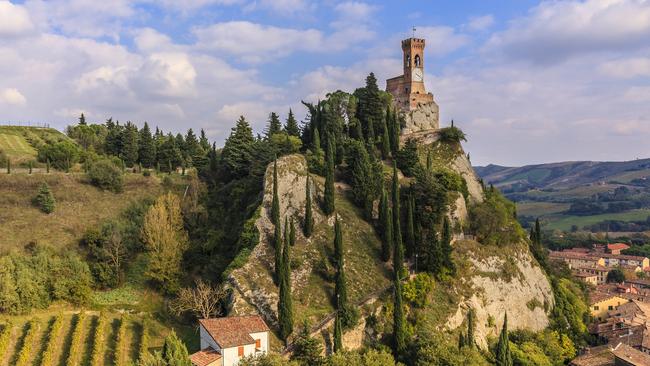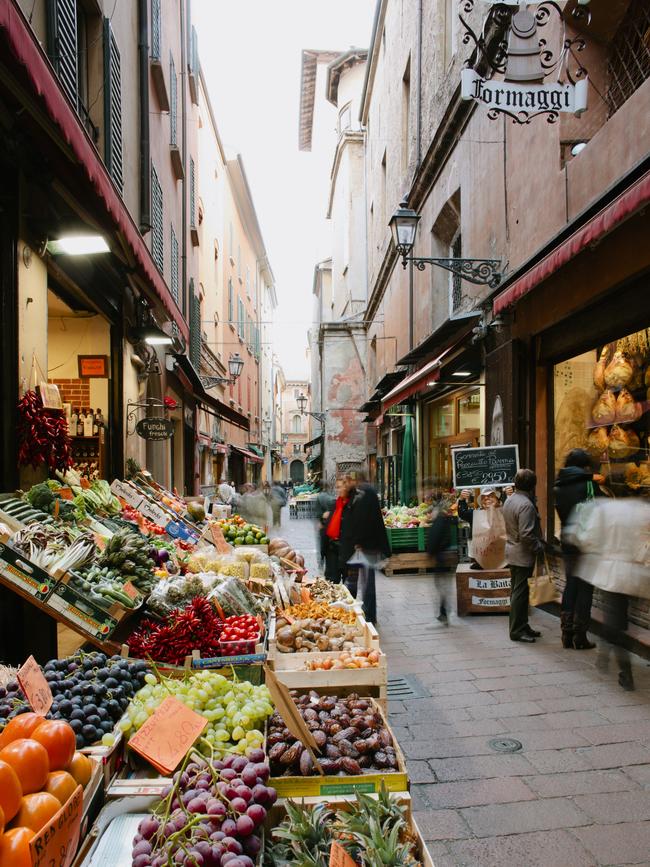Walking tours of Italy
The rewards are rich on a guided walking holiday from Bologna to Ravenna.

When Cole Porter first visited the north Italian town of Ravenna, he was so bowled over by the Byzantine mosaics in the Mausoleum of Galla Placidia that he later sat down to write his unforgettable show song, Night and Day. It was 1932. The prolific American composer was on his honeymoon and as he gazed up at a scattering of gold stars juxtaposed against a blue mosaic sky, the image of a romantic star-studded night popped into his mind.
I’m thinking of him as I gaze at that same dazzling dome, and at a very contemporary-looking 5th-century mosaic scene of doves in a panel below. I’m also humming his timeless song (not too loudly, I should add) but yes, there’s a “hungry burning” inside of me, though not as Cole Porter intended in the lyrics for the tune.
My burning is pure muscle ache and is the culmination of walking almost 65km (admittedly spread over six days), all the way from Bologna to this buzzy town. The hunger of course is from walking, though soon there will be the satisfaction of truly delicious Italian food, which is a dominant feature on this wonderful journey.
I’ll return to Ravenna’s delights later. Let me first take you to Bologna, where I am to join 14 others on Hedonistic Hiking’s escorted walking holiday through northern Tuscany. This city is where we start our loop through a part of the region that has largely escaped tourism. Not for us the crowded streets of Florence or lazing around a vineyard-flanked pool. Instead, we’re discovering a more remote Tuscany through sometimes challenging terrain. The rewards, though, are rich landscapes punctuated by cypresses and olive groves, alongside wild violets and orchids underfoot.

Bologna, with its sprawling historic Quadrilatero food market, proves a fitting start to our gastronomy-focused adventure. Our appetite-rousing hikes, led by Australian Mick Parsons, are always interspersed with locally sourced lunchtime feasts (often prepared by his British-born wife, Jackie) in attractive locations. Each day there’s a trek, then lunch where Mike reads to us a passage from Dante, perhaps a discourse on viticulture, or chapters from novels set in Tuscany. Then the walking resumes before we check into our hotel for the night.
Like most of the company’s Italian walks, accommodation is comfortable and full of character, rather than luxurious. They are the sort of places you’d easily bypass without the recommendation of someone in the know. Even better, gorgeous wines pattern our days and evenings; and at dinners, there are usually at least three of the region’s top labels, chosen by Mick and Jackie to complement the food.
We’re a convivial mob, ranging in age from thirtysomethings to seventy-plus: a smattering of Americans and Australians, then three Brits. Yet age becomes irrelevant, and some of the keenest and quickest are the post-retirees.

Find yourself in the lead? Mike is adamant that the hares should wait for the tortoises to catch up, and it makes sense. On our first day, a couple go buzzing off at great speed, taking the wrong turn without realising their error. We are covering a series of circular rather than linear walks, which means staying in hotels for two or three nights. It is an agreeable way to ensure much-needed downtime. There’s never any bother about lengthy check-ins or waiting for keys. Everything is sorted before our arrival.
Inevitably, there are stand-out moments. A five-hour hike on our second day sees us following mule tracks through an atmospheric beech wood where we stumble across an abandoned Franciscan church as beautiful as a dream. Cobwebs festoon its confessional; swifts have nested in the crumbling stonework and, in the distance, there’s the haunting call of a cuckoo. Our hike rises to a steep ridge with fantastic views over the Apennines.
Later, we arrive in Palazzuolo sul Senio. Swifts screech like avian hooligans around its ancient bell tower, where Jackie has set up a picnic on a red-checked tablecloth. It’s a feast of Tuscan delights. There are fennel-studded salamis, tender agreti greens with toasted hazelnuts, and warm crescentine dough balls stuffed with gooey raviggiolo cheese. Peaches, cherries and creamy cakes are served alongside glasses of velvety Tuscan wine. And, remarkably, we are already finding that wine at lunchtime doesn’t seem to bludgeon us. Maybe this is because it’s of such high quality and mostly organic.

Our base is Locanda Senio, an Albergo Diffuso with a variety of rooms spread across the town. Some hikers are in apartments with roof terraces; I have a small yet snug bedroom with views over the church to distant hills. Later, we cram into a cosy enoteca – wine shop at the front, rustic dining room at the back – where proprietor Francesco uncorks countless bottles of premium Sangiovese to accompany our grilled Tuscan T-bone.
Another memorable journey sees us setting off in a dense mist from our hotel, Villa Campestri. Rain threatens, but as we climb, the sky clears to the sight of two eagles circling way overhead. We are heading for breezy Monte di Giove, a 992m peak that dominates this broad-valley region, snaked by the River Sieve. From its summit, we gaze over hills and valley, from the vineyards of Chianti Rufina to the ochreous glitter of Florence’s distant skyline. Equally enjoyable are visits to small, sleepy towns such as Vicchio, where Giotto was born; or an unforgettable hike through the Val d’Inferno, where Dante once walked.
A memorable final walk sees us swapping rural emptiness for urban zing. We leave Tuscany for Romagna, following a sheer trek along the Apennine ridge that sees us nervously minding our footfall. Wind whips at our jackets. The route is challenging, but once confidence has returned we gaze out on karst peaks and gypsum-embedded rocks that glint in the sunshine. As we skirt Via Salaria, the old Roman salt route, the remoteness gives way to a softened scene of tussocky hills capped with umbrella pines. It is a landscape straight from a Renaissance painting that’s made more vivid when the turreted castle and bell tower of Brisighella appear.
It’s an astonishingly pretty town, and a fine preparation for Ravenna which, as Cole Porter discovered, has a bounty of charms. In ancient history, Ravenna was an important port. Augustus had half his navy stationed here. Then it played a key role at the end of the Roman Empire when the capital was moved to Constantinople, today’s Istanbul.
Under Justinian’s rule, Ravenna became a pillar of the Byzantine Empire, and among the town’s bright and buzzy streets you can find plenty of delightful 1500-year-old mosaic-filled churches: Cole Porter’s favourite mausoleum, then San Vitale with its haughty 6th-century portrait of Empress Theodora, alongside the stunning wall mosaics of Sant’Apollinare in Classe.
Later, as a day scene of flowers sellers, tourists and swifts swooping over domes segues to Ravenna’s night crowd of diners and revellers, I find a serene square. The air is balmy and I am content to sit, free of my hiking boots, drinking an Aperol spritz and enjoying the scene. Night and Day. All it needs is Fred Astaire to appear and whisk me off in a dance, and my happiness would be complete.
Louise Roddon was a guest of Hedonistic Hiking.
In the know
Hedonistic Hiking’s Northern Tuscany and Ravenna escorted walks run from October 13-20, 2022 and October 4-11, 2023; €3050pp ($4523); single supplement, €350. Includes seven nights' accommodation in three hotels, all meals and wine (including at restaurants), guiding, transport, transfers and museum visits.

To join the conversation, please log in. Don't have an account? Register
Join the conversation, you are commenting as Logout